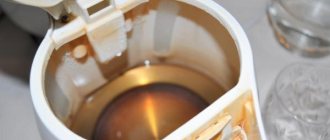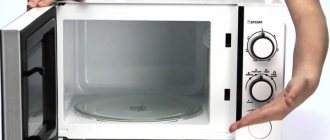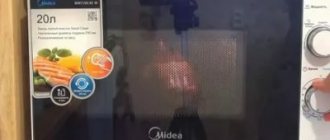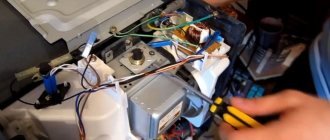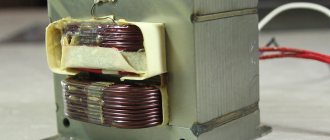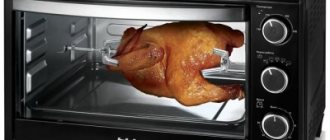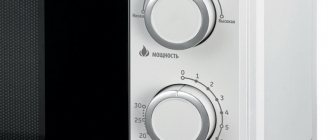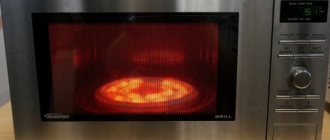Causes of coating deformation
The inside of a microwave oven has to be washed regularly because it becomes dirty with grease and food debris. If you use a hard brush or abrasive detergents for cleaning, micro-scratches appear on the surface - the paint chips, cracks, and peels off. The integrity of the material is damaged - the road to its deterioration is open. Scratches cause rust to appear inside. This is not the only problem; in addition to rust stains, there may be other defects - their nature depends on the coating material.
Inner covering material
If the enamel peels off in the microwave, do not rush to write it off as scrap - restoration is possible. By painting the inside of your camera, you will extend its service life by another 2-3 years. The nature and causes of deformation depend on the type of coating.
Ceramics
- It is hard, but has a drawback: it is too fragile.
- Due to mechanical stress, cracks and chips appear on the ceramics.
- The smoothness of ceramics is a plus; fat does not stick to the smooth surface so much. Any dirt can be easily wiped off with a regular foam sponge soaked in soapy water.
Stainless steel
- Durable and reliable, resistant to temperature changes. The downside is that it’s difficult to clean off grease stains.
- Do not clean with abrasive or aggressive agents as this may cause scratches or stains.
- Clean with steam, special products for microwave ovens or kitchen cleaning liquids.
Enamel
- Food enamel is the most short-lived option. It is used in inexpensive models. Thanks to their low cost, they are leaders in the buyer ratings.
- Pros: smoothness and lack of pores. Cleans well, especially with regular care.
- Aging and deformation due to natural working conditions. Over time, high temperatures, hot steam, fat, and detergents disrupt the structure of the material - it becomes loose.
- The next stage is total destruction. Bubbles appear, the material separates from the metal in pieces, and after a short time the owners discover that their microwave has rusted inside.
- If you look inside an old microwave oven, you can see that the enamel on the ceiling and bottom is the most peeling. The ceiling is more exposed than others to the hot steam that rises during cooking. The bottom deteriorates due to liquid spilling from the dishes in which food is cooked or heated.
If you do not respond to damage, the microwave will crack and spark. It won't work for long in this mode - it will break down.
The owners are interested in whether it is possible to paint the interior walls of the chamber. It is possible, but only in one case - if they are covered with enamel.
How to paint the inside of a microwave?
- Remove all removable parts and cover the rotary drive shaft and the mica protective plate with masking tape. Also, if you have a microwave with a grill, use its grate.
- Remove any grease deposits on the surface of the chamber using laundry soap, detergents such as Ferry and even solvents.
- Remove loose paint and rust using either a rust remover or mechanically using fine sandpaper. Remember that after using a rust remover, its residues should be thoroughly rinsed off, because the phosphoric acid contained in them does not contact well with most paints, incl. mentioned.
- After drying the surface, apply paint in 2 - 3 layers with intermediate drying of each.
The result should be like this.
If the damage to the body has minor through damage to the metal, then they should be patched before painting. You can do this as shown in the video:
Or you can apply a patch on the back side, dismantling the bottom of the stove, and putty it with automotive putty flush with the rest of the surface. Otherwise, the unevenness of the groove for the wheels of the turning mechanism will subsequently be accompanied by additional sound effects when the stove is operating.
It is better to paint either outdoors or in a well-ventilated area. After the paint has completely dried, and this will happen no earlier than in a day, we recommend carrying out the procedure for removing residual odor. To do this, boil a liter of water in the microwave.
Finally, we offer you a video with a radical repair of the microwave oven housing. Most stoves in such a deplorable state must be disposed of, but their restoration in a similar way is also possible:
We recommend other articles on the topic
DIY vibration table - various manufacturing options
Selection and use of a glue gun
We assemble a manual concrete mixer with our own hands from an old bicycle
DIY wood lathe: manufacturing options
What colors are suitable?
Most owners of a microwave oven, having discovered that it is rusty, prefer to throw it away and buy a new one. If wastefulness is not your thing, you will have a question: what to do, how to extend the life of the microwave? Paint the damaged surface. The main thing is to find the right paint; not every paint is suitable for this task.
Let's look at the dyes that can be used if the microwave is rusty.
Food-grade organic is the best solution
Recommended brands: KO-5102 and BEP-5297. The downside is the high price of organic dyes.
Pros:
- withstands high temperatures, alcohol steam, acid, and high humidity;
- non-toxic - made for the food industry;
- prevent corrosion;
- waterproof.
The dye adheres especially well to aluminum and other metal surfaces. The paints are approved by the Ministry of Health and are allowed to be used in the food industry. Apply with a brush or roller, whichever is convenient.
Electrically conductive
They use Zinga (Belgium) or KO-8111 enamel.
They contain zinc, aluminum, silver or shungite. Once dry, the dye turns into a durable layer that is resistant to any negative influences. It can easily withstand temperatures of 150-200 degrees. Adheses well to the surface. Used infrequently due to high cost.
Shungite. Shungite is a rock with high electrical conductivity, strength and density. It is used to make heat-resistant and antistatic bases.
Acrylic car
Are you wondering how to paint your microwave to avoid big expenses? Then acrylic is for you. Compared to previous options, this is the simplest and most inexpensive dye. It is sold in cans, so it is very easy to use. With one can you can paint the entire camera in one layer.
Microwave oven repair from the inside - from mechanical restoration to painting
Horror stories about the dangers of microwave ovens are shattered by their sales figures. It’s rare in any home today that you don’t see a microwave. And although the average service life of these devices is determined to be 5–7 years, many of them faithfully serve their owners for 10 years or more. But quite often they are scrapped not because of the failure of the electronic part, but because of the banal wear and tear of the case. Most often it rusts from the inside.
At the factory, most of these stoves are coated with high-quality enamel, which can last for many years with basic care.
There are microwave ovens that have internal chambers made of stainless steel or ceramic coating. We will not talk about such devices in this article; they have other problems not related to painting.
Causes of damage to the enamel inside a microwave oven
First of all, let's talk about what causes rapid damage to the enamel surfaces inside the microwave, what should be done to prevent this from happening, and how to eliminate minor flaws in the enamel coating.
If your microwave has minor damage to the enamel where the door fits or minor scratches caused mechanically that have not yet become rusty, then degrease them and cover the defects with any enamel, nitro paint, or even nail polish that matches the color. Such repairs will delay the more labor-intensive and expensive restoration of the paintwork for a long time.
And more serious accelerated wear occurs due to:
- failure to comply with basic operating rules;
- irregular stove maintenance;
- inattention.
- Thermal processing of products in a microwave oven should be carried out by first covering them with a plastic cap or other container that is approved for use in microwave ovens. Splashing food particles during heating or cooking, settling on the walls of the chamber, destroy the enamel at an accelerated pace. Electrical discharges are also possible between them, causing sparking and crackling.
- The oven requires basic cleaning, which is best done at least once or twice a week or after each case of splashing of fat, and even more so of spilling liquid under the glass tray.
- It is the latter that leads to the most typical wear of not only the paint coating, but also the metal of the body.
Moreover, it accelerates due to the rolling of the wheels of the pallet rotation mechanism along the recess. And if this liquid is not removed in time, then the result will be exactly like this. And pretty soon.
How to paint the inside of a microwave - choosing paint
If you don't change the microwave, all that's left to do is paint it. First of all, let's figure out what.
The answer suggests itself - enamel, since that is what they paint at the factory. When choosing a paint, make sure it can be used on items that come into contact with food. This should be indicated on the label.
If you have a regular microwave without a grill, then the heat resistance of the paint does not matter, because the body does not heat up during operation.
And if you have a stove with a grill, then you should use paints that can withstand temperatures from 250°C. There can be no talk of any 600 degrees, because at such a high temperature food is simply destroyed and cannot be there.
Painting stages
We found out how to restore the original beauty and integrity of the surface. All that remains is to find out how to apply paint correctly. The process can be divided into 4 successive stages:
- Sandpaper is used to clean surfaces from rust, bubbling, and peeling paint.
- Degrease with an alcohol solution.
- All holes inside the chamber are sealed with tape.
- Dye is applied. Wait for it to dry completely. If necessary, cover with a second layer.
As it turns out, the main reason for premature microwave wear is careless maintenance. If you properly clean the microwave oven chamber from grease deposits, there will be no problems. Do not rush to throw away the oven due to defects in the coating. Choose one of the dyes discussed above and paint it quickly - don’t wait for it to break.

